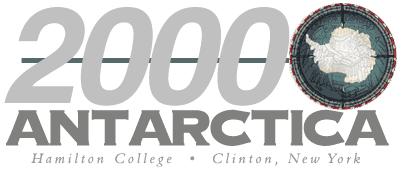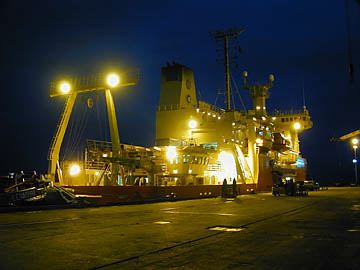
Training
Lit up like a small city, the Nathaniel B. Palmer as seen at night, tied up to the main pier in Punta Arenas.
We are still in port in Punta Arenas and will be sailing around 7 pm Wednesday, May 10. Most of tomorrow will be spent in meetings including ship and lab safety briefings, deck operations, and ping editing training. Ping editing involves processing data that the ship collects to produce 3- dimensional maps of the sea floor.
Sensors on the ship's hull send out a signal that is reflected off the bottom and returned to the ship. The time it takes for the signal to arrive back to the ship depends on the depth to the bottom. Shallower water, faster return, deeper water longer time to return. Computers process the time it takes for each signal to return and begin to draw a map of the ocean floor. Motion of the ship, such as rocking or turning, causes some of the data points to be inaccurate. Every hour the mapping computers save the files and start new ones. The saved files are then opened and reviewed to look for corrupted data which is edited out. This is ping editing. Every hour the ship is in motion a data file is created resulting in a maximum of 24 data files that must be edited each day. We will begin collecting data once we pass the 200 mile limit and continue to collect data until we reach the 200 mile limit on our return trip. These files can take up to an hour to edit and each member of the science team edits one file a day on top of the 12 hour shift they work to collect and process the samples from the ocean floor.
Punta Arenas latitude & longitude is 53 degrees 10 minutes south & 70 degrees 54 minutes west. The weather is calm and cloudy with temperature around 35 degrees.
Dave Tewksbury
